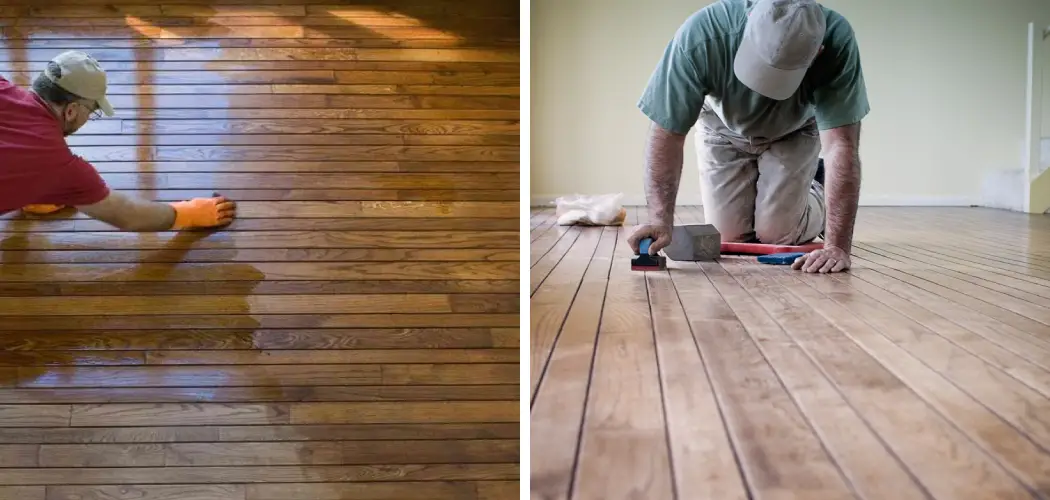Are you tired of seeing your hardwood floors look old and worn out? Maybe they’re riddled with scratches, dents, or water stains. If so, refinishing your distressed hardwood floors may be the solution!
Refinishing distressed hardwood floors is a transformation journey, turning worn and weathered wood into a polished, enduring surface. The character etched into distressed floors tells a unique story, and with careful refinishing, that story is preserved while restoring the floor’s original luster and strength. This guide will walk you through the essential steps needed how to refinish distressed hardwood floors, from assessing the extent of the damage to the final touches of sealing and protecting your newly refreshed floors.
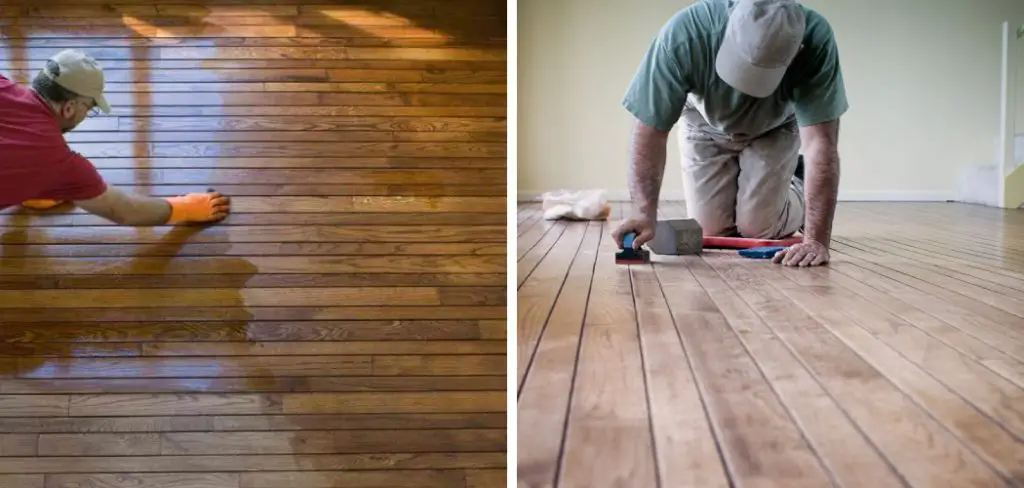
Whether you’re a seasoned DIY enthusiast or a newcomer to home renovation, refinishing your hardwood floors is a rewarding endeavor that can dramatically enhance the beauty and value of your home.
What are the Reasons for Distressed Hardwood Floors?
There are a few common reasons why hardwood floors may become distressed over time. Some of the most common causes include:
- Heavy Foot Traffic: High levels of foot traffic can cause wear and tear on your hardwood floors, leading to scratches, dents, and other forms of damage.
- Water Damage: Exposure to water or moisture can cause hardwood floors to swell, warp, or rot.
- Pet Nails: If you have pets in your home, their nails can easily scratch and damage your hardwood floors.
- Furniture: Moving furniture around or dragging heavy objects across the floor can leave behind scratches and scuff marks.
- Age: Over time, all hardwood floors will naturally develop wear and tear due to aging and use.
Understanding the reasons behind your distressed hardwood floors will help you determine the best course for refinishing them. For example, if your floors have significant water damage, they may require more intensive repairs before refinishing. Or, if your floors are simply showing signs of wear from heavy foot traffic, a light sanding and refinishing may be all that’s needed.
Assess the Damage
Before diving into the refinishing process, it’s essential to assess the extent of the damage on your distressed hardwood floors. This step will help you determine what repairs or preparation work needs before beginning the refinishing process. Here are a few key factors to consider when assessing your floors:
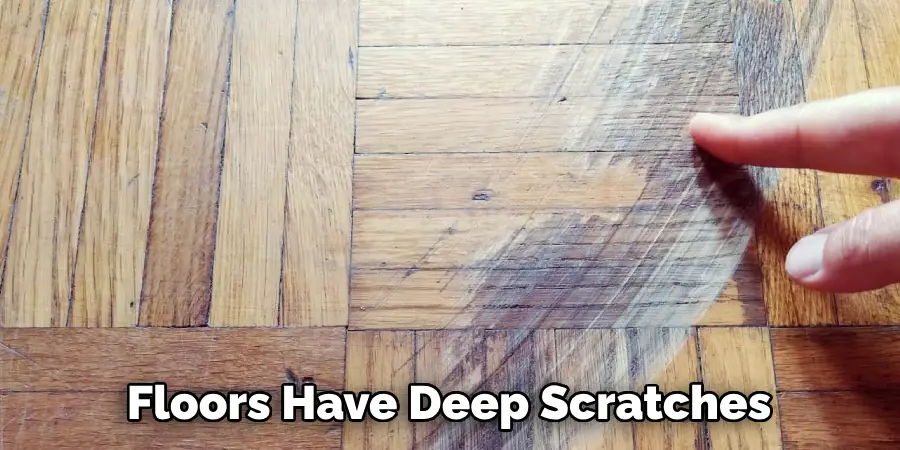
- Deep Scratches and Gouges: If your floors have deep scratches or gouges, you may need to fill them with wood filler before sanding and refinishing.
- Water Stains: Water stains can be tricky to remove; in some cases, they may require bleaching or sanding to disappear completely.
- Worn Finish: If the finish on your hardwood floors is worn down to the bare wood in some areas, you’ll need to sand those spots down before refinishing.
- Warping: Warping or cupping occurs when hardwood floors are exposed to too much moisture, causing them to warp and buckle. If this is the case with your floors, they may require more extensive repairs before refinishing.
What Will You Need?
To refinish your distressed hardwood floors, you will need the following materials and tools:
- Sanding Equipment: This includes a drum sander, edger, sandpaper, and sanding discs of various grits.
- Vacuum Cleaner or Broom: You’ll need to thoroughly clean your floors before beginning the refinishing process.
- Wood Filler: If you have deep scratches or gouges, you may need to fill them with wood filler before sanding.
- Chemical Stripper: This will help remove any old finish or stains on your floors.
- Stain and Sealant of Your Choice: You can choose from various stains and finishes depending on the desired look for your floors.
Once you have all the necessary materials and tools, it’s time to refinish your distressed hardwood floors!
10 Easy Steps on How to Refinish Distressed Hardwood Floors
Step 1. Clear the Room
Before initiating any refinishing operations, it’s vital to clear the room of all furniture and removable fixtures. This provides you with an unobstructed workspace necessary for maneuvering equipment and safeguards your items from dust and damage during sanding and refinishing. Ensure electrical outlets are covered and doors sealed with plastic sheeting to contain dust. If removing certain fixtures isn’t possible, carefully cover them with drop cloths or plastic to protect from dust and debris.
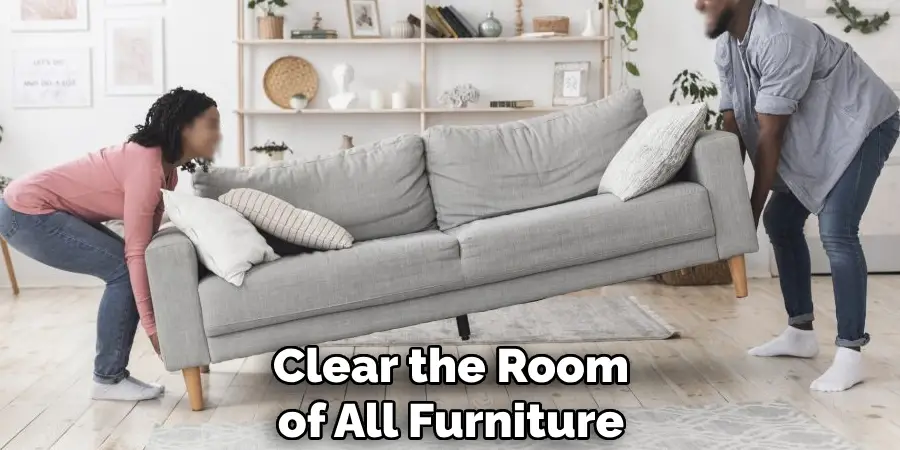
Step 2. Repair and Prep the Floors
Once the room is clear, closely inspect the hardwood for any signs of damage. Use wood filler to repair deep scratches, gouges, or holes, following the manufacturer’s instructions for best results. After the filler has dried, prepare by sweeping or vacuuming the floor thoroughly to remove any loose debris. If necessary, use a chemical stripper to help remove old finish or stains; wear protective gloves and work in a well-ventilated area. Allow the floor to dry completely before moving on to the next step.
Step 3. Sand the Floors
Begin with the heavier-grit sandpaper to tackle the larger gouges and imperfections. Equip your drum sander with sandpaper and methodically work across the entire floor area, going with the wood grain to avoid additional scratches. When the significant irregularities have been smoothed out, switch to a finer grit sandpaper to refine the surface. An edge sander can be employed to reach into corners and along baseboards where the drum sander can’t operate effectively.
Sanding must be approached patiently and meticulously to provide a flawless canvas for the subsequent finish. After completing the sanding process, vacuum the floor again to eliminate all dust and particles, ensuring a clean base for staining and sealing.
Step 4. Stain the Floors
After the thorough sanding process, it’s time to stain your hardwood floors with the color of your choice. Opt for a stain that complements the wood’s natural hue and fits with the overall aesthetic of your home. Begin by applying the stain in the corner furthest from the exit, working your way toward the door to avoid being trapped by the wet stain.
Use a clean cloth or a sponge to apply the stain liberally, then wipe away any excess stain to prevent uneven coloring or blotches. Remember, the longer the stain sits before wiping, the darker the finish will be. Allow the paint to dry according to the manufacturer’s instructions before applying additional coats if a deeper color is desired.
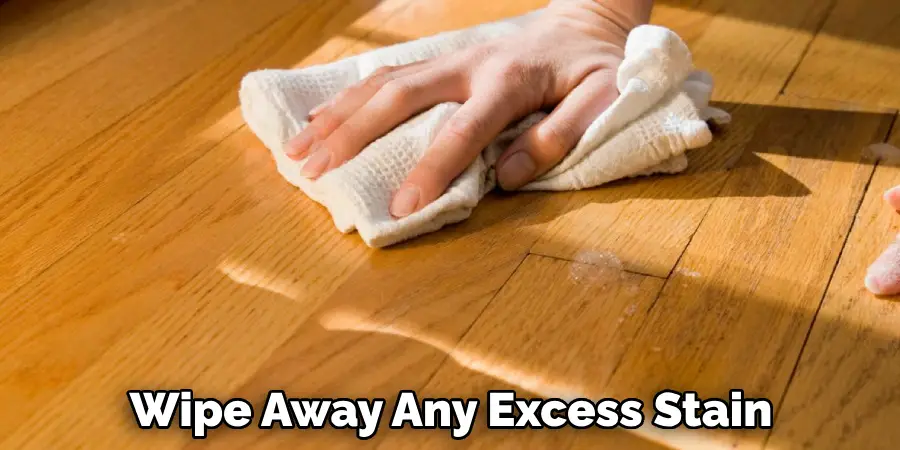
Step 5. Apply the Sealant
Once the stain has thoroughly dried, it’s time to seal your hardwood floors to protect the newly applied color and ensure its longevity. Choose a high-quality polyurethane sealant for a durable finish that can withstand everyday wear and tear. Start by applying a thin, even coat using a fine-bristle brush or a foam applicator, being careful not to leave streaks or pools.
Work in sections, maintaining a wet edge to avoid lap marks as you move along the floor. Be sure to ventilate the room well during this process to avoid inhaling fumes. Allow the first coat to dry as per the sealant manufacturer’s recommended time; then, lightly sand the surface with fine-grit sandpaper to eliminate any bubbles or imperfections before applying the second coat. Repeat the process if additional coats are required for optimum protection.
Step 6. Light Sanding Between Coats
After the initial sealant layer has dried, it’s essential to perform a light sanding. This step helps to create a smooth base for the next layer and ensures strong adhesion. Using a fine-grit sandpaper or sanding screen, lightly buff the entire floor. Be careful to sand evenly to avoid creating dips or swirls on the surface. Once sanded, vacuum the floor to remove all dust, then wipe it down with a tack cloth to ensure no particles are left behind to mar the final finish.
Step 7. Apply Additional Coats of Sealant
With the floor prepped, apply the second coat of sealant. Follow the same method, using a fine-bristle brush or foam applicator to achieve an even layer. Consider adding a third coat for durability or a glossier finish. Make sure to sand between each coat lightly, clean the surface thoroughly, and allow ample drying time per the sealant manufacturer’s instructions.
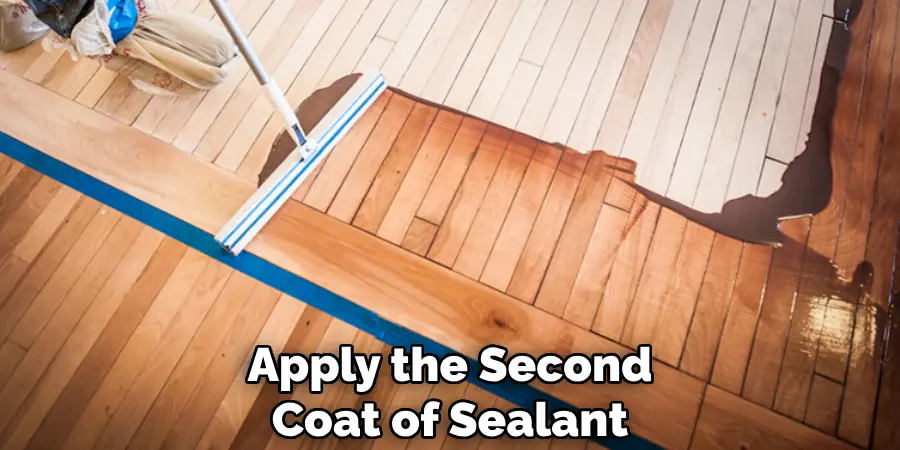
Step 8. Final Clean-Up
Once the final coat of sealant has dried completely, remove all the plastic sheeting from doors, coverings from fixtures, and masking from electrical outlets. It’s essential to wait before placing furniture back into the room to avoid damaging the new finish. Now, thoroughly clean your tools and store them properly for future use.
Step 9. Restore the Room
Carefully move furniture and other items back into the room. Use felt pads under furniture legs to protect your newly refinished floors from scratches. Reattach and return any fixtures or hardware that were removed during the process. The room is now refreshed, and the lustrous floors are ready to be showcased.
Step 10. Maintenance Tips
To maintain the beauty and longevity of your freshly refinished hardwood floors, regular maintenance is crucial. Avoid using harsh cleansers or abrasive tools that can damage the finish. Instead, opt for pH-neutral cleaners and soft mops or cloths for cleaning. Protect high-traffic areas with rugs and address spills promptly to prevent moisture damage. With the right care, your hardwood floors will remain a stunning home feature for years.
Following these steps, you can refinish your hardwood floors and give them a new lease on life. Remember to take your time, pay attention to detail, and always follow the manufacturer’s instructions for the best results. With patience and care, you can achieve beautiful, lustrous floors that add value and charm to your home.
5 Additional Tips and Tricks
- Test Finishes First: Before refinishing the entire floor, choose a small, inconspicuous area to test your desired stain and finish. This ensures compatibility with the wood and lets you see the final look before proceeding.
- Use the Right Sandpaper Grit: Start with a coarser grit to remove the old finish and scratches, then progressively move to finer grits for a smooth base before applying a new finish.
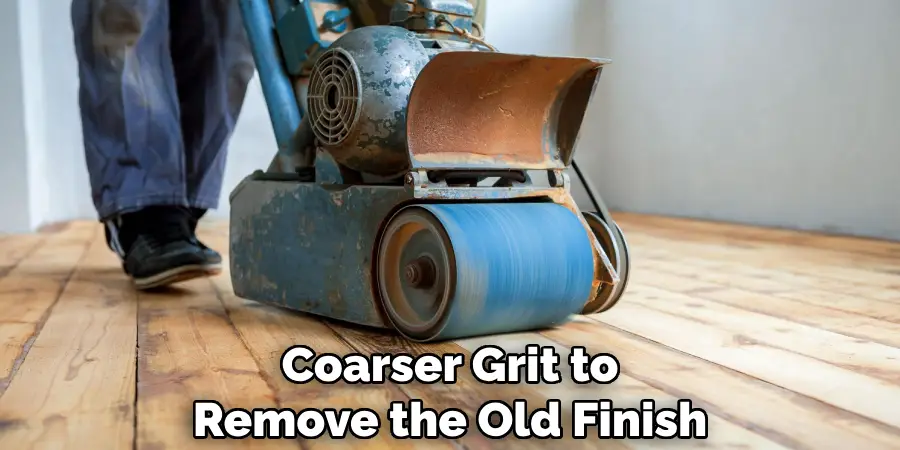
- Buff Between Coats: Carefully buff or sand lightly between coats of finish. This step is essential for an even, professional-looking surface that highlights the natural beauty of your hardwood floors.
- Maintain Optimal Conditions: Keep the room at a stable temperature and humidity level to ensure the finish dries evenly and to prevent warping or cracking of the wood.
- Protect Your Work: Once the final coat is dry, place felt pads under the legs of the furniture, and avoid using rugs with rubber backings to prevent damage to the new finish. Regular cleaning with products specifically designed for hardwood floors will also extend the life of your refinishing job.
With these additional tips and tricks, you can confidently refinish your distressed hardwood floors and achieve a beautiful, long-lasting result. Remember always to follow safety precautions when working with chemicals and power tools, and don’t hesitate to seek professional help.
5 Things You Should Avoid
- Skipping Prep Work: Never bypass the preparation phase, which includes cleaning, sanding, and repairing any damaged areas. Proper prep is crucial to a seamless refinishing process.
- Using Inferior Materials: Avoid using cheap stains or finishes, which can lead to poor coverage, uneven color, and premature wear. Investing in high-quality products will ensure the best look and longevity.
- Ignoring Dust Control: Pay attention to minimizing dust during sanding. Excessive dust can settle into the finish, ruining the smooth surface. Utilize dust containment systems or seal off work areas to keep the space clean.
- Rushing the Process: Refinishing is a multi-step procedure, and rushing through the stages can result in unsatisfactory results. Allow ample time for the stain and finish to dry between applications.
- Neglecting Proper Ventilation: Ensure the workspace is well-ventilated when applying stains and finishes. Inadequate ventilation can lead to harmful fume buildup and slow drying times.
- Being Fearful of Color: Don’t be afraid to experiment with different stain colors to achieve your desired look. You can always test a small area first and gradually build up the color until you get the desired result.
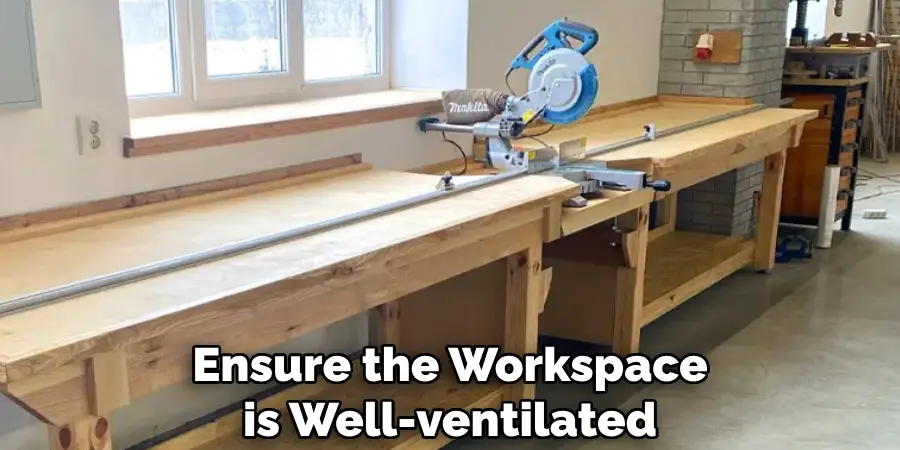
Avoiding these common mistakes can save time, money, and frustration in your hardwood floor refinishing project.
How Do You Take Care of Distressed Wood Floors?
- Regular Cleaning: To maintain the beauty of your newly refinished hardwood floors, keeping them clean is essential. Use a soft broom or vacuum with a hardwood floor attachment to remove dust and debris regularly.
- Avoid Harsh Chemicals: Avoid using harsh chemicals or abrasive cleaners on distressed wood floors, as they can damage the finish and cause discoloration.
- Wipe Up Spills Immediately: Accidents happen, but cleaning up any spills or messes on your hardwood floors is crucial. Prolonged exposure to liquids can cause the wood to warp or stain.
- Use Mats and Rugs: Place mats or rugs at entryways and high-traffic areas to prevent dirt and debris from scratching or damaging the finish of your distressed wood floors.
- Schedule Professional Maintenance: It’s recommended to have your hardwood floors professionally cleaned and maintained every 1-3 years, depending on the level of foot traffic and wear and tear.
By following these maintenance tips, you can keep your distressed wood floors looking beautiful for years.
How Can You Shine Hardwood Floors Without Refinishing?
If your hardwood floors are looking dull and lackluster, there are a few ways to bring back their shine without the hassle of refinishing:
- Use a Hardwood Floor Cleaner: Many commercial cleaners specifically designed for hardwood floors can help restore shine. These products typically contain mild cleaning agents and oils that nourish and rejuvenate the wood.
- Try a DIY Solution: If you prefer a natural, homemade solution, mix equal parts white vinegar and water in a spray bottle and use it to clean your floors. The acidity of the vinegar helps cut through dirt and grime, while the water provides moisture to restore shine.
- Use Floor Polish: Floor polish is another product that can help bring back shine to dull hardwood floors. Choose a high-quality polish designed for hardwood floors and follow the instructions carefully.
- Buff with Olive Oil: For a quick fix, you can also buff your hardwood floors with a small amount of olive oil on a soft cloth. This will provide an instant shine and nourish the wood at the same time.
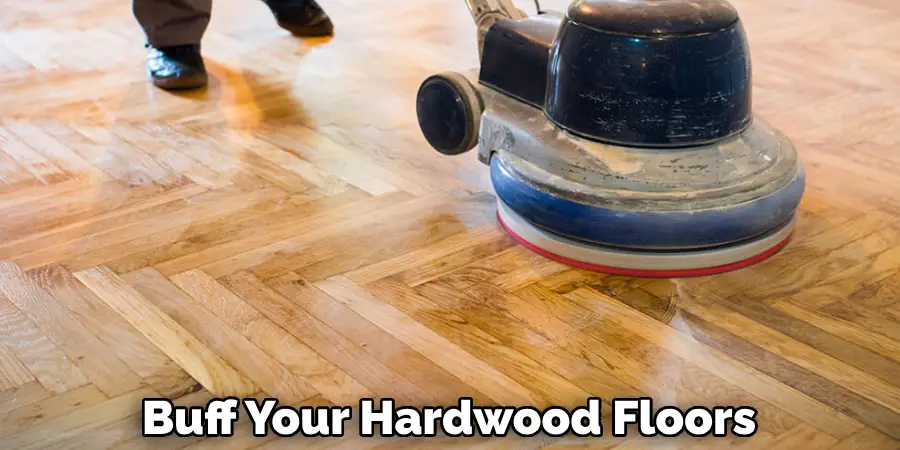
Remember, these methods will only enhance the appearance of your hardwood floors temporarily and should not be seen as a long-term solution.
Conclusion
How to refinish distressed hardwood floors allows homeowners to breathe new life into their space, preserving the character and charm of their flooring while ensuring durability and a fresh appearance.
By following a thorough preparation process, using suitable materials, and applying meticulous care to each step, even heavily worn floors can be transformed into elegant surfaces that stand the test of time. Moreover, by steering clear of common mistakes and committing to regular maintenance, the rejuvenated beauty of the floors can be extended for many enjoyable years.
Ultimately, whether you undertake this task as a DIY project or with professional assistance, the key to success lies in patience, attention to detail, and a commitment to quality—the results will be a stunning and enduring addition to your home.

